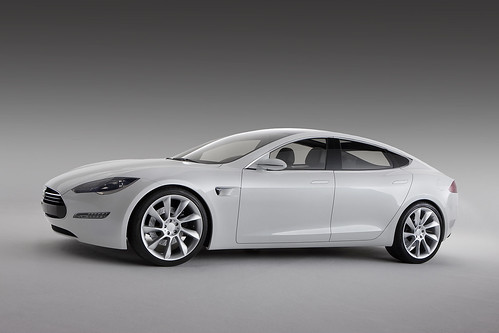Strategic partnership for an era of electro-mobility: Daimler acquires 10% stake in Electric Car Maker Tesla
(Source: TeslaMotors@Twitter)

Looks like the German automaker, Daimler AG (maker of Mercedes vehicles) strongly feels about the growth of electric vehicles in the market. Early this morning TransportGooru received the hot alert from Tesla’s Tweet that Daimler has acquired 10% of the company. Sweet Deal!!! It will be a great & mutually beneficial relationship for both parties as it not only provides the much needed financial capital for Tesla, it also allows for collaborative development of technologies that will be deployed in the future platforms manufactured by either company.
• German automaker acquires nearly 10 percent of one of the leading electric vehicle companies
• Automakers agreed to cooperate in battery systems, electric drive systems and vehicle projects
The press release on Tesla’s Website is here for you to read..
May 19, 2009
STUTTGART, Germany, and SAN CARLOS, Calif.
– Daimler AG has acquired an equity stake of nearly 10 percent of Tesla Motors Inc. This investment deepens the relationship between the inventor of the automobile and the newest member of the global auto industry. Tesla is the only production automaker selling a highway capable electric vehicle in North America and Europe.
The two companies have already been working closely to integrate Tesla’s lithium-ion battery packs and charging electronics into the first 1,000 units of Daimler’s electric smart car. In order to benefit from each other’s know-how, the investment enables the partners to collaborate even more closely on the development of battery systems, electric drive systems and in individual vehicle projects.
“Our strategic partnership is an important step to accelerate the commercialization of electric drives globally,” said Dr. Thomas Weber, Member of the Board of Daimler AG, responsible for Group Research and Mercedes-Benz Cars Development. “As a young and dynamic company, Tesla stands for visionary power and pioneering spirit. Together with Daimler’s 120 years of experience in the automotive sector this collaboration is a unique combination of two companies’ strengths. This marks another important milestone in Daimler’s strategy for sustainable mobility.”
“Daimler has set the benchmark for engineering excellence and vehicle quality for more than a century. It is an honor and a powerful endorsement of our technology that Daimler would choose to invest in and partner with Tesla,” said Tesla Chairman, CEO and Product Architect Elon Musk. “Daimler is also on the leading edge in the field of sustainable mobility. Among others the lithium-ion pouch-cell battery developed by Daimler and especially designed for automotive applications is of interest to us. We are looking forward to a strategic cooperation in a number of areas including leveraging Daimler’s engineering, production and supply chain expertise. This will accelerate bringing our Tesla Model S to production and ensure that it is a superlative vehicle on all levels.”
Together on the road to electro-mobility
As part of the collaboration, Prof. Herbert Kohler, Vice President E-Drive and Future Mobility at Daimler AG, will take a seat on Tesla’s board of directors.
This long-term partnership with Tesla complements Daimler’s multi-facetted strategy to advance the electrification of the automobile.
Daimler is also moving forward the industrialization of lithium-ion technology. In March, the company founded the Deutsche Accumotive GmbH, a joint venture with Evonik Industries AG. As a result, Daimler is the first vehicle manufacturer worldwide that develops, produces and markets batteries for automotive applications. This is based on a Daimler stockholding in Li-Tec, the German specialist for lithium-ion battery cells.
100 smart electric cars have already been undergoing large-scale trials in London since 2007. These electric vehicles are being tested in day-to-day assignments by fleet operators and private customers.
Later this year the smart assembly plant in Hambach, France, will start production of up to 1,000 units of the second-generation smart fortwo with electric drive, which will initially be used for mobility projects such as e-mobility Berlin or e-mobility Italy. This year Daimler is also starting small-series production of the Mercedes-Benz B-Class with a fuel cell drive system. In 2010 the company will introduce its first battery-powered Mercedes-Benz. As of 2012, Daimler plans to equip all smart and Mercedes-Benz electric vehicles with own produced lithium-ion batteries.
In 2004, Tesla began development of its first electric vehicle, the Roadster, which remains the only highway capable EV for sale in North America or Europe. The Tesla Roadster is the first production battery electric vehicle to travel more than 200 miles per charge and the first US- and EU-certified lithium-ion battery electric vehicle. This green supercar accelerates from 0 to 60 mph in 3.9 seconds yet gets the equivalent of 256 miles per gallon. The Roadster, which travels an estimated 244 miles per charge with zero tailpipe emissions, is the first production vehicle to break the historical compromise between automobile performance and efficiency.
The Tesla Model S builds upon the success of the Tesla Roadster by leveraging its technology into the world’s first fully electric sedan. Based in Silicon Valley, Tesla unveiled the Model S in March and plans to produce it in California starting in late 2011.










